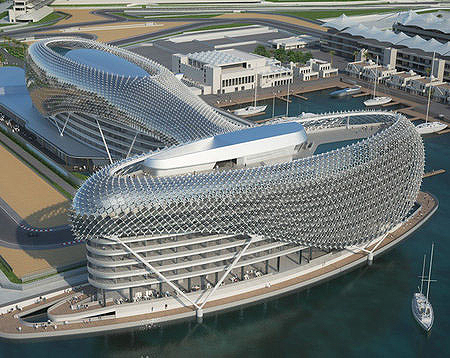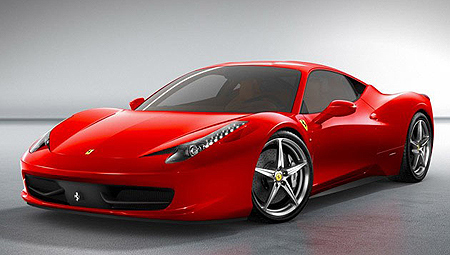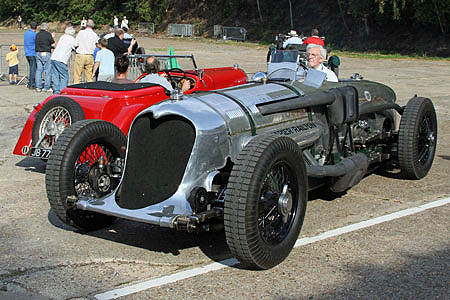 |
|
 |
| AUTO MANIA:
by Dr. Iain Corness |
|
|
|

Abu Dhabi Grand Prix this weekend

Abu Dhabi
The Abu Dhabi Yas Marina grand prix circuit hosts the
second last GP of 2011 this weekend. Abu Dhabi is the most oil-rich in the
region and ‘home’ to some well-heeled ‘visitors’ from Thailand.
The 5.55 kilometer Yas Marina Circuit was constructed
using the motorists’ money, extracted at the petrol pumps. Roll on electric
power! It was also one of the most boring race tracks in living memory at
its debut and last year was no better, universally christened ‘Yawn’ Marina.
My report in 2010 contained the phrase: “The race was processional and quite
frankly, another bore-fest.” Despite the advent of the overtaking aids KERS
and DRS, I cannot see KERS and DRS producing the excitement required by the
spectators, as after all, neither of these aids did anything to assist the
Indian GP.
Located on Yas Island, the PR blurb said the track was
set to revolutionize the design of future Formula One circuits. Boasting top
speeds of 320 km/h and average speeds of 198 km/h, it features nine right
turns and 11 left turns and is one of the few venues on the calendar to run
in an anti-clockwise direction.
It was designed by circuit architect Hermann Tilke (so
need I say more), and Yas Marina has a waterfront setting scenic enough to
rival the likes of Monaco and Valencia, complete with a hotel that changes
color, but was just as boring as that former pair of venues.
All of the grandstands, including the massive hairpin
seating area, are covered to protect spectators from the desert sun, whilst
the state-of-the-art pit building boasts 40 garages.
As well as the waterside marina area, there are
high-speed sections, tight corners for overtaking (or so they tell us), and
even a twisty street circuit-style sector. However, none of this prevents
Yas (Yawn) Marina from being boring if the F1 cars cannot pass each other.
However, always the optimist, I shall be there glued to the screen in
hopeful anticipation.
The race will start at 8 p.m. our time Sunday (Qualifying
is also 8 p.m. on the Saturday), and I will be getting to Jameson’s Irish
Pub around 7 p.m. for a bite to eat (specials are great value) and a glass
or two. Come and join us for the third Abu Dhabi Grand Prix. Jameson’s is on
Soi AR, next to Nova Park serviced apartments and we watch the BBC telecast
on the huge screen with no adverts.
|
|
 |
Ferrari betting on its reliability

Ferrari 458 Italia
Ferrari is touting a seven year free servicing offer in
Australia, following on six months after it became available in Europe. However,
before you rush to the local Ferrari agent with your 458 Italia, Thailand’s
position in this scheme has not yet been announced.
Designed to reduce the cost of Ferrari ownership and provide
customers of the Prancing Horse brand with more peace of mind, the Ferrari
Genuine Maintenance program applies to the new FF coupe, California convertible,
458 Italia coupe and upcoming 458 Spider - but not the recently discontinued 599
GTB flagship. (Damn, I wonder if I can get a rebate on mine?)
Many other mainstream brands offer shorter term, fixed price
routine service campaigns, but the Ferrari free-service deal covers all
scheduled maintenance at standard service intervals (20,000 km, or once a year
with no restriction on kays covered) and includes original spare parts, engine
oil and brake fluid.
Ferrari claims the program, which was introduced in Italy in
April 2011 and is fully transferable to subsequent owners, is the first of its
type to be offered by any car-maker globally, demonstrating the attention it
pays to its customers.
The Ferrari Genuine Maintenance plan is part of the
after-sales services for Ferrari, which they say is unmatched by any other
brand. The services include the Ferrari Approved used-car program, the Ferrari
Power Warranty that can cover a pre-owned Ferrari for up to nine years, Ferrari
Pre-Owned Search, Ferrari Genuine spare parts, the Ferrari Classiche valuation
and restoration service and Ferrari Pilota driving courses.
These services are actually quite astounding, but whether
Thailand can afford, or even justify, them is another matter.
|

|
Natter Nosh and Noggin
The next car club meeting will be at Jameson’s Irish Pub on
Soi AR next to the Nova Park development. The monthly meetings are on the second
Monday of the month, so this week it is on Monday November 14 at Jameson’s at 7
p.m. This is a totally informal meeting of like-minded souls to discuss their
pet motoring (and motorcycling) loves and hates. Many interesting debates come
from these evenings. Come along and meet guys who have a common interest in cars
and bikes, and enjoy the Jameson’s specials, washed down with a few beers. We
have even had a couple of F1 scrutineers with tales from the Parc Ferme. I am
sure one of our regulars, Ken Gibson, will bring his new toy (a Maserati
BiTurbo) down for the evening. Might even see if I can bring the Securitas Mk1
Escort Retro Racer down as well.
|

|
Back to the Future?

EV DeLorean
Remember the DeLorean, the gull-winged star of the Back to
the Future movie series? Well, if the reports out of the US are to believed, the
DeLorean is back, and “re-amped” to be an electric vehicle.
The original DeLorean was built in Ireland, and there were
all kinds of innuendo and rumor-mongering surrounding the car and its maverick
automaker John Zachary DeLorean, including his arrest for drug involvement. This
was a charge he successfully defended using particularly smart legal procedures.
Texas entrepreneur Stephen Wynne purchased the name and
remaining parts inventory in 1995 and started the current “DeLorean Motor
Company (DMC)”. Since 2007, around 40 DeLoreans were produced from the spare
parts. With the car now a cult classic, DMC hopes to immortalize the company
with an EV powered DeLorean.
The EV power comes from the Epic EV company, which has
produced a 200 BHP electric motor which is being engineered to fit into new
DeLoreans, and retro-fitted to existing vehicles.
DeLorean plans to market the new DMC EV in the US in 2013
after assessing the prototypes currently being manufactured.
The original DMC 12 sold for USD 12,000 in 1981, but the new
DMC EV will have a USD 100,000 ticket.
You can contact DeLorean at www. delorean.com.
|

|
If you’ve got a $10 head, wear a $10 helmet
“If you’ve got a $10 head, wear a $10 helmet” was a very
famous advertising catch phrase put forward by Bell Helmets in the 1960’s. It
really did get the message through, but it did not get through to SE Asia,
unfortunately.
Over the years, I have had a series of helmets. One was
actually kept by the Confederation of Australian Motor Sports, the straps cut to
ensure nobody tried to use it, and it was stored without any cleaning of the
external surface. Why? Because this was the helmet I was wearing when I was
caught in a fire. The back of the helmet was melted and the rest of the helmet
was blackened from the smoke. I was quite happy to see that particular helmet
being used to drive a point home to novice drivers.
However, it is interesting to look at the history surrounding
the use of helmets, starting with motorcycle helmets. The Motorcycle Rider’s
Association of Western Australia (MRAWA) researched this topic and went back as
far as T.E. Lawrence, otherwise known as Lawrence of Arabia, who died from brain
injuries in 1935 following a motorcycle accident.
One of the neurosurgeons who attended Lawrence was Australian
Dr. Hugh Cairns. He was profoundly moved by the tragedy of this famous First
World War hero dying at such a young age from severe head trauma. Having been
powerless to save Lawrence, Cairns set about identifying, studying, and solving
the problem of head trauma prevention in motorcyclists.
In 1941, his first and most important article on the subject
was published in the British Medical Journal. He observed that 2279
motorcyclists and pillion passengers had been killed in road accidents during
the first 21 months of the war, and head injuries were by far the most common
cause of death. Most significantly, however, Cairns had only observed seven
cases of motorcyclists injured while wearing a crash helmet, all of which were
nonfatal injuries. His 1946 article on crash helmets charted the monthly totals
of motorcyclist fatalities in the United Kingdom from 1939 to 1945. The obvious
decline in the number of fatalities took place after November 1941, when crash
helmets became compulsory for all army motorcyclists on duty. His article
concluded: “From these experiences there can be little doubt that adoption of a
crash helmet as standard wear by all civilian motorcyclists would result in
considerable saving of life, working time, and the time of hospitals.”
It was not until 1973, 32 years after his first scientific
article on the subject, were crash helmets made compulsory for all motorcycle
riders and pillion passengers in the United Kingdom. And many years after that
for the use of crash helmets to be legislated in Thailand, and some SE Asian
nations are yet to follow.
However, legislation alone is not enough. Helmets have to be
of a sufficient standard to give the protection needed. The plastic bucket
favored by some motorcycle taxi passengers is worth very little as far as saving
lives is concerned. There needs to be a standard, and the US Snell Foundation is
one such organization.
For us ordinary mortals, selection of a good helmet is a
matter of first checking to see if it is certified by Snell, or British
Standard, or DOT. After that, select the one that fits your head, we are not all
of the same size! The helmet should be a bit snug when brand new, as it will
pack down a little bit to fit your head.
And by the way, be careful if you are going to have your
helmet painted, some external shells do not like the thinners in some paints.
For this reason, I use stickers on my helmets, rather than paint.
We have come a long way since the leather helmets worn by
drivers such as Prince Bira and Juan Manuel Fangio in their heyday, and it has
been the advances in technology that have made today’s helmets as good as they
are.
|

|
Autotrivia Quiz

Napier Railton
Last week I asked what car did ‘Mr Bean’ drive up the hill at
the Goodwood Festival of Speed in 2007? It was John Cobb’s aero-engined Railton,
a regular record breaker at the old Brooklands Circuit. As an amazing
coincidence, Anthony Howard in the UK sent me the following pic, taken at a
small ceremony on October 1 this year!
So to this week. We are all familiar with traffic lights
(even though largely ignored in Thailand). The world’s first traffic light was
installed in Detroit in 1919, but when was the first three-color traffic light
installed in the UK, and where?
For the Automania free beer this week, be the first correct
answer to email [email protected].
|
|
 |
|
 |

